written and photographed by Mary L. Peachin
Jan 2005, Vol. 5 No. 3
 The frigid, turbulent waters of Hudson Bay solidify in late fall, allowing the local cadre of polar bears to migrate northward over the ice packs toward their seal-hunting grounds—leaving their summer home on the barren tundra surrounding the frontier town of Churchill, Manitoba. The bears are hungry; since the spring thaw, they’ve eaten little but berries, and their lethargy is evident. At a distance, when the monstrous canine incisors and claws are hidden, these great animals look like nothing so much as oversized creamy-white teddy bears—a far cry from the ferocious, sometimes cannibalistic carnivores they are.
The frigid, turbulent waters of Hudson Bay solidify in late fall, allowing the local cadre of polar bears to migrate northward over the ice packs toward their seal-hunting grounds—leaving their summer home on the barren tundra surrounding the frontier town of Churchill, Manitoba. The bears are hungry; since the spring thaw, they’ve eaten little but berries, and their lethargy is evident. At a distance, when the monstrous canine incisors and claws are hidden, these great animals look like nothing so much as oversized creamy-white teddy bears—a far cry from the ferocious, sometimes cannibalistic carnivores they are.
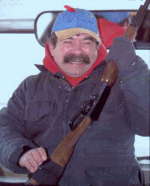 Photographers, naturalists, and rabid “wildlifers” from around the world converge on Churchill for six weeks each fall, hoping to observe one of nature’s great thrills. The town itself defines the word “frontier”: at the northern reaches of Manitoba, it can be accessed only by air or train, and it’s the last stop on the train line before Canada shades off into near-uninhabited tundra. The main street, Kelsey Boulevard, has no stoplights or paving, and the town’s 1000 residents are outnumbered by an estimated 1200 polar bears.
Photographers, naturalists, and rabid “wildlifers” from around the world converge on Churchill for six weeks each fall, hoping to observe one of nature’s great thrills. The town itself defines the word “frontier”: at the northern reaches of Manitoba, it can be accessed only by air or train, and it’s the last stop on the train line before Canada shades off into near-uninhabited tundra. The main street, Kelsey Boulevard, has no stoplights or paving, and the town’s 1000 residents are outnumbered by an estimated 1200 polar bears.
It’s no surprise, then, that Churchill has some strict bear-management policies. Patrols track bears, hoping to prevent bear confrontations with humans. Bright-green bear alert signs (call 675-BEAR) are posted wherever a bear is sighted. Around the outskirts of town lie trailer-size traps of galvanized steel pipe, baited with rancid seal meat. And no one walks outside of town without carrying a rifle. (Guide Paul Ratson—who showed me the nearby Prince of Wales Fort, built by the Hudson’s Bay Company to protect British interest in the fur trade—brought his Marlin 4570 rifle on our brief walk. On our return he emptied the shells, explaining, “It’s better to have and not need than to need and not have.”
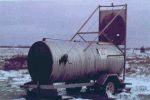 I was in Churchill to view the bears, joining a group of 20 other animal lovers from the United States, Australia, and Japan who’d signed on for a five-day International Wildlife Adventures tour. We wasted no time, at the airport we boarded a somewhat decrepit school bus that took us to the Churchill “polar-bear jail.” Any bear that wanders into town or chooses to dine at the town dump (known colloquially as the “Polar Bear Dining Room”) is tranquilized and taken to the jail—a corrugated Quonset hut, formerly a military garage, that has been divided into 25 “cells.” Captured bears are kept in solitary confinement here until the autumn freeze, at which time they’re released and head eagerly to their hunting grounds. On average, 100 bears do time each year. No food is served; the captors don’t want bears conditioned to show up for the meals. If the cells are filled, a few bears are flown out to the ice flow, making room for new “incorrigibles.”
I was in Churchill to view the bears, joining a group of 20 other animal lovers from the United States, Australia, and Japan who’d signed on for a five-day International Wildlife Adventures tour. We wasted no time, at the airport we boarded a somewhat decrepit school bus that took us to the Churchill “polar-bear jail.” Any bear that wanders into town or chooses to dine at the town dump (known colloquially as the “Polar Bear Dining Room”) is tranquilized and taken to the jail—a corrugated Quonset hut, formerly a military garage, that has been divided into 25 “cells.” Captured bears are kept in solitary confinement here until the autumn freeze, at which time they’re released and head eagerly to their hunting grounds. On average, 100 bears do time each year. No food is served; the captors don’t want bears conditioned to show up for the meals. If the cells are filled, a few bears are flown out to the ice flow, making room for new “incorrigibles.”
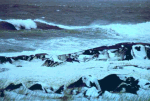 Unlike grizzly and black bears, which hibernate during winter months, the polar bear is active throughout the year. As Paul joked, “All these bears are Capricorns,” born in December or January. Adult bears breed every two years, in April and May; pregnant females are an exception to the migration, heading inland to den for the winter.
Unlike grizzly and black bears, which hibernate during winter months, the polar bear is active throughout the year. As Paul joked, “All these bears are Capricorns,” born in December or January. Adult bears breed every two years, in April and May; pregnant females are an exception to the migration, heading inland to den for the winter.
The rest of the first day is spent touring Churchill. The next day, we show up at eight, excited about our first up-close view of the bears in the wild. We board one of the 18 “tundra buggies,” each of which is a converted fire engine holding between 26 and 52 people, warmed by a portable propane heater. The single-gear buggies lurch across the tundra on their 600-pound, 52-inch Goodyear tires. We wipe the steamy windows with paper towels passed out for the task.
 Rocking and rolling, the buggy travels between 12 and 14 miles a day towards Gordon Point, about a 45-minute drive from the buggy depot. We scour the glaciated rocky terrain in search of bears. The tundra is barren except for a few willows and white spruce, all bent toward the southeast by blasts of crystalline snow. “The direction of the tree is true; the compass can lie,” says Paul. He points out the minimal vegetation, the few species that can survive at below-zero temperatures. A thin film of grease ice covers the many ponds leading out to Hudson Bay, the gateway for the migration.
Rocking and rolling, the buggy travels between 12 and 14 miles a day towards Gordon Point, about a 45-minute drive from the buggy depot. We scour the glaciated rocky terrain in search of bears. The tundra is barren except for a few willows and white spruce, all bent toward the southeast by blasts of crystalline snow. “The direction of the tree is true; the compass can lie,” says Paul. He points out the minimal vegetation, the few species that can survive at below-zero temperatures. A thin film of grease ice covers the many ponds leading out to Hudson Bay, the gateway for the migration.
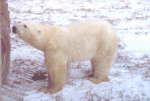 The first bear is sighted, and we hurriedly open windows, craning for a look. The serious photographers rush to claim a spot on the open rear deck. Our driver approaches cautiously so as not to frighten the bears, but that seems unnecessary: several curious bears rise up on two feet to paw the sides of the vehicle, while others nibble at the tires. The photographers went crazy, eating up the photogenic antics.
The first bear is sighted, and we hurriedly open windows, craning for a look. The serious photographers rush to claim a spot on the open rear deck. Our driver approaches cautiously so as not to frighten the bears, but that seems unnecessary: several curious bears rise up on two feet to paw the sides of the vehicle, while others nibble at the tires. The photographers went crazy, eating up the photogenic antics.
In the next two days, our buggy will encounter more than two dozen bears. They’re wholly unafraid; a stopped buggy frequently attracts a “bear jam,” with other vehicles in the vicinity heading over to see which way cameras are pointing or to confirm driver-radioed sightings. Even with the traffic, there are enough bears to go around, and everyone returns to Churchill visually satiated.
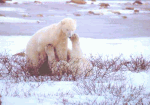 In those two days, we saw several sub-adult males, described by one guide as “testosterone with teeth,” playfully sparring. One adult bear was enthusiastically gobbling seaweed at the shore of Hudson Bay, while a mother with a yearling cub snuggled in a snowbank in front of a lone spruce. Some bears lazed along the four-wheel track, while other rambled up to the tundra buggy. After cautiously testing the strength of an ice pond, another shuffled across.
In those two days, we saw several sub-adult males, described by one guide as “testosterone with teeth,” playfully sparring. One adult bear was enthusiastically gobbling seaweed at the shore of Hudson Bay, while a mother with a yearling cub snuggled in a snowbank in front of a lone spruce. Some bears lazed along the four-wheel track, while other rambled up to the tundra buggy. After cautiously testing the strength of an ice pond, another shuffled across.
Each offered something new to see. The buggy ride was long and somewhat jarring, but time passes quickly when you are gazing and gasping at the magnificence of these creatures. And though feeding the bears is not allowed, all humans were served a daily lunch of soup, sandwiches, and sweets. Each evening at 4:30, the buggies returned to the depot in the encroaching dark. After the half-hour bus ride back to town, we had dinner and roll into an early bed, looking forward to warm and fuzzy dreams about our bear encounters.
If you go:
When to go: Bear migration is dependent on ice formation; the most reliable time to go is October through November. Reservations should be booked a year or more in advance. It is very difficult to travel independently because tours companies block space, but if you do so, be sure to factor in the cost of transportation, accommodations, and the tundra buggy. Summer months in Churchill offer caribou and wildflowers, the beluga whale migration (an estimated 3500 whales) up the Churchill River, and birding (more than 200 species), as well as flyfishing for Arctic grayling. During the winter months, when the sky is clear, the Aurora Borealis, or northern lights, can be observed.
Where to stay: Churchill offers a dozen hotels and bed and breakfasts, all fairly basic (few amenities and no food service). Many hotels have kitchenettes; visitors can purchase food at the nearby Northern Store. I stayed at the Aurora Inn, (888-840-1344 or e-mail aurora@cancom.net/~aurora) which offers loft rooms (each with a bedroom and bath above the living area).
Restaurants: Churchill offers basic cuisine in about seven restaurants. This is not a gourmet destination; my favorite place was the Trader’s Table, located near the Aurora Inn.
Other things to do: Visitors can explore the Hudson’s Bay Company’s Fort Prince of Wales, or journey to Cape Merry. Advance reservations are necessary at Epic Sled Dog Adventures, where John and Shelley Stetson educate visitors about Canadian Eskimo dogs, then take them on a 10-15 minute sled ride. Kelsey Blvd., the main drag, has a number of tourist shops and an Eskimo Museum.
Transportation: Calm Air makes twice-daily flights into Churchill. Be sure to take into consideration the possibility of flight cancellations due to inclimate weather. The 32-hour one-way train trip between Winnipeg and Churchill can be made on VIA Rail. (1-800-561-8630).
Tundra Buggy Tours Ltd.(R) offers bear-watching tours at $160.00 US per day. Call 1-800-544-5049, e-mail info@tundra-buggy-tours.com, or go to www.tundra-buggy-tours.com.
For further information: Frontiers North Adventures: Call 1-800-593-8881, www.frontiersnorth.com and www.tundrabuggy.com
